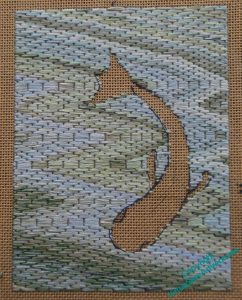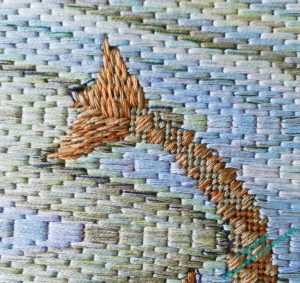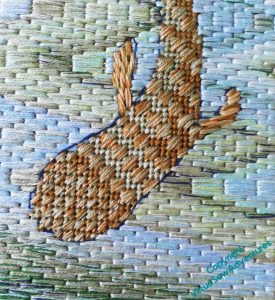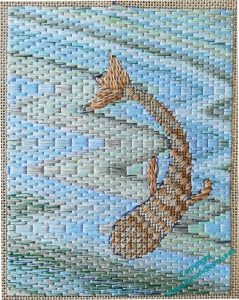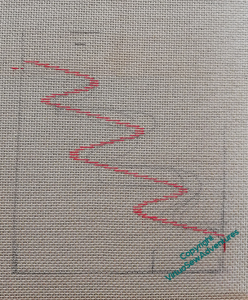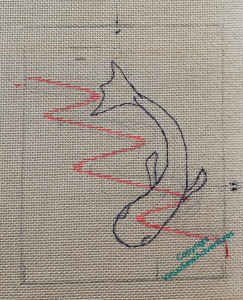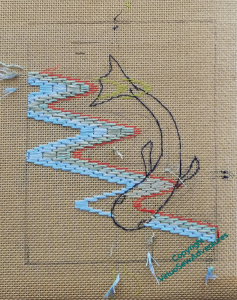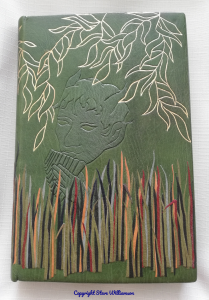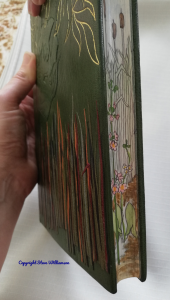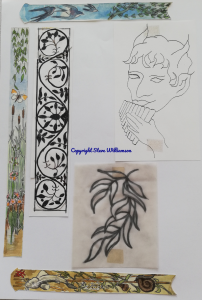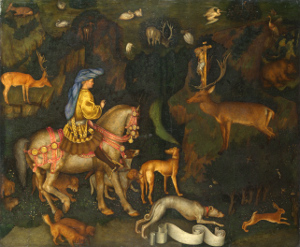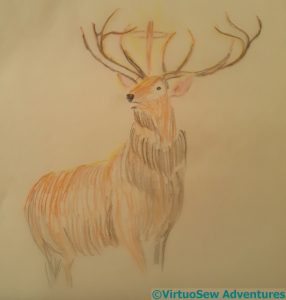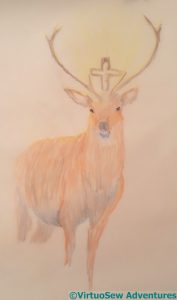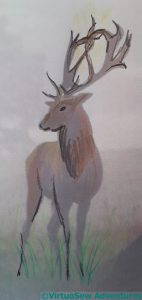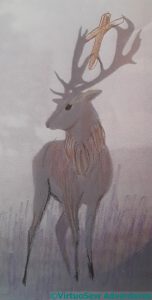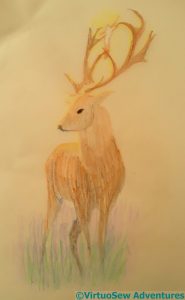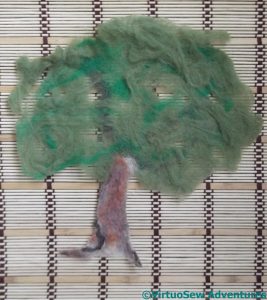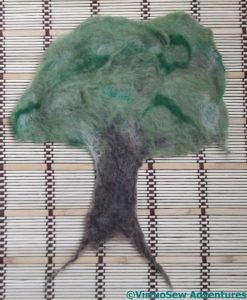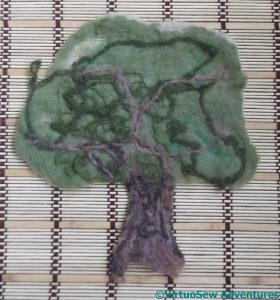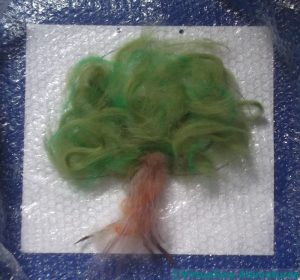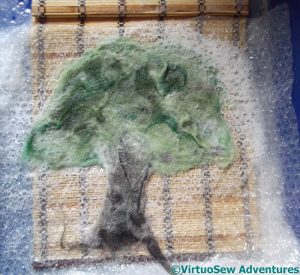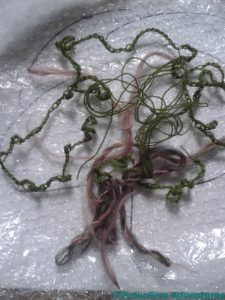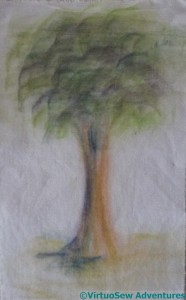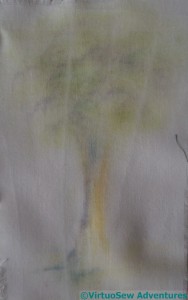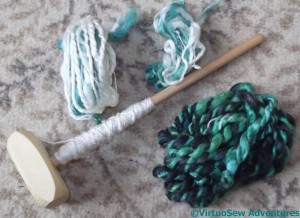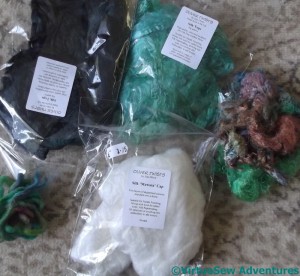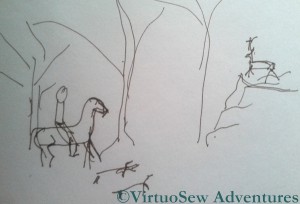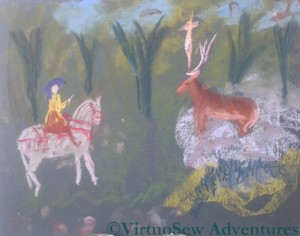Tag: Vision of Placidus
First Fishie Experiment Finished…
The background of freeform Bargello was rather entertaining to do. Working using nine strands of stranded cotton allowed for some subtlety in the colours, combining various blues and greens in different proportions and shading them into one another, sometimes gradually, sometimes stongly. I was surprised, sometimes, when progressively adding a particular colour, to find that it didn’t make as much difference as I expected – but this is why we experiment!
Once I came to the Fishie himself, there was a bit of puzzlement. I wanted to have a different pattern for the head, the fins and tail, and the body. I wanted a vaguely “scale-like” pattern, and I wanted to make sure that the stitches were at a different orientation to the water.
I settled on Moorish Stitch for the body, Mosaic Stitch for the head, and Encroaching Gobelins Stitch for the fins and tail. And I left in the tacked outlines. They only show in a few places, and I think they give the impression of sketched lines, which is quite suitable for an exploratory piece. I’ve also left out the eyes, since I’m looking from above.
Looking at it now, I’m pleased with the sense of flowing water that the bargello nearly creates, and the fish is interesting, but maybe not entirely successful. Some of the edges and joining points are a little clumsy – but that may be because this is an experiment, thrown together to see what I learn.
I’ve had at least one idea for another fishy experiment, so you will be seeing more of this sort of thing…
And indeed, Episode 54 of SlowTV Stitchery describes the beginning of the Second Fishy Experiment, in which I begin a second fishy experiment, this one attempting to give the impression of the fish seen through water, making some slight changes to the form of the freeform bargello, and anticipating tussles with my very leftoverish leftover thread.
An experiment for Placidus
Bear with me, please!
At the moment, the idea for The Vision of Placidus is that the main picture – the encounter between Placidus and the Christ/Stag – will be framed with a depiction of denizens of the natural world – underwater creatures in the lower section, bulrushes and dragonflies in the upright sections, and birds in the upper section. I’ve been thinking of putting the symbols of the Evangelists in the corners, to obviate the necessity of dealing with getting the design around those corners.
However, what I’ve not yet sorted out is the technique I might choose to use. This is going to be an experiment to see whether using canvaswork – a sort of freeform Bargello with embellishments – will create a pleasing effect.
I was really very pleased with how quickly this came together when I began thinking about it. The red line is a guide for the freeform Bargello, representing the current in a stream, and the fish is simply there to help me test how to deal with the boarders between the flowing background and the motifs.
That might be easiest to achieve if I worked the fish, and then added in the background, but if I do that, I think it will be nearly impossible to place the background correctly on the far side of the fish. So this time, I’m doing the background first, putting in the stitches across the fish in sewing cotton, as a sort of “draft”.
I’m using stranded cotton, separated and combined to create blended shades. As it turns out, six strands are not quite enough for full coverage, so here I am using nine.
Episode 51 of Slow TV Stitcery is now live, including a comparision of bone and steel laying tools, consideration of two possibilities to experiment with for Placidus, and thoughts about taking sagas seriously.
Thoughts on the Next Big Project
I’ve been continuing to think about The Vision of Placidus, but part of my inspiration has shifted, from the mille fleurs background of the the Unicorn Tapestry, to the edge-painting my mother did for a Fine Binding she made of The Wind In The Willows.
An edge painting is exactly what it says: colour added to the edge of the codex of a book, often in patterns or pictures that relate to the story or theme of the book.
So, although there may still be animals in mille fleurs fashion in odd spaces in the picture, I’m also planning to design a border. Underwater will be shown below the main image, just above the water surface on the vertical edges, and the sky on the upper border.
This design sheet shows the design of the edge painting for the book, to give you some idea of what I am thinking about.
There will be a pike underwater, I’m sure, and the vertical borders will be where the kingfisher, and maybe some dragonflies, can go. I might spend some time looking at the symbolism of various animals, just to make sure that the right creatures show their faces.
The corners will probably have the symbols of the Evangelists, but at the moment I’m not sure in quite what style..
In other news, Episode 40 of SlowTV Stitchery is now live, in which we move to the Christmas playlist, discuss the tension between economy and adequate coverage, and express surprise at the amount of real history one can learn from well researched fiction.
Thinking about the stag for the Vision of Placidus
I’ve already mentioned that, although I have more yet to do on the Dreams of Amarna, I have little thoughts, now and again, about my plans for the next Really Big Project, the Vision of Placidus, inspired by Pisanello’s “Conversion of St Eustace”, Elizabeth Goudge’s “Herb of Grace”, my mother’s fine binding of “The Wind in The Willows”, and the kingfisher I saw at Flag Fen. Oh, and the “Chasse a la licorne” tapestry in the Musee de Cluny.
The Stag with the crucifix in his antlers is going to be the major character, and while I know I’m tearing into a genius of the past, I think Pisanello’s stag is a bit too tame for the story…
My first thought was to start from Sir Edwin Landseer’s Monarch of the Glen. After all, he’s full of personality and presence, and a recognisable figure to add to the layers of meaning and reference. But no, I think the crucifix won’t settle well into the antlers, and the pose isn’t quite right, either….
Then I spent more time rummaging online for pictures of stags, and came up with another to try. I like the challenging, direct stare of the pose here, but it puts the onlooker in the position of Placidus (according to the stories, he took the name “Eustace”, or more probably a Latin variant thereof, when he became a Christian), and I want Placidus to be in the picture. That said, he was a second century Roman, and I’m intending to dress him in florid fourteenth century dress, so don’t expect too much accuracy…
My next thought came from a book about the landscapes of Capability Brown that I bought for my cousin for Christmas. I’ve told her about the plans for Placidus, and she opened her gift, leafed through it, and then turned the book to me and said “Would this help?”
This is by no means the first time my cousin has helped me with design planning – it was talking to her that enabled me to crystallise the ideas for the Dreams of Amarna – and I like the photo enough to have three attempts at it. I still don’t think I’ve got it right. That said, all of these sketches have allowed me to think, not just about the pose, but about how I will use my threads to create the effect I want, of the illumination in the scene emanating from the crucifix.
A good use of time, even if not a stitch was set!
Some early (very early!) experiments for the Vision Of Placidus – Part Two
Once everything had dried, I could sit back and look at my trees.
This is the first one I did. It used some multicoloured merino in the trunk, and two greens from the beginners felting kit I bought on eBay a while back. They’re not very nice greens, but all I’m doing is investigating the technique.
There are only two or three layers of wool in this one, which means there are gaps in the felt, and the junction of the trunk and the canopy is a bit flimsy. Gaps in the felt for the canopy are no problem at all – they would help to add depth to the finished piece. Since everything will be caught down (somehow – I don’t yet know how!), strong, dense felt isn’t really the aim here.
The second experiment had the addition of some short staple (that is, short fibre length), very crinkly wool. I was hoping it would result in greater shrinkage, which it has a little. It also produced a greater variety of shades in the canopy, lightening and interrupting that rather dull green. This may have promise, and the felt itself seems a little more stable and would be easier to stitch into.
Since the fibres are rubbed and soaped and rolled, and generally beaten up, it’s not surprising that the effects of trying to place the fibre colours to create a particular appearance is, to put it mildly, an inexact science. I wonder whether I could combine needle-felting with wet-felting to make the results more controllable?
In the final experiment, I added crocheted chains and some tangles of yarn as well. Some parts of the chain didn’t felt in quite as well as I might have hoped, but with more crocheted chain and a better understanding of how to felt it in more thoroughly, it might produce a very good effect.
My semi-spun yarn on the trunk has worked, though, and looks even better in real life, although, again, what it needs is the courage of my convictions and rather more of the same.
So, not a completely unsuccessful experiment, and certainly a good basis for further experiments, perhaps with added stitching…
Some early (very early!) experiments for the Vision Of Placidus – Part One
I’ve been struggling with a sore and stiff shoulder for some months now. It’s made me reluctant to go back to Eve In The Garden of Eden because at this stage she demands perseverance in a single, small stitch for the gold groundwork. The Head of Nefertiti has involved more variety, and earlier signs of progress, while the canvaswork is perfect for evenings.
However, my shoulder is beginning to ease and I’m feeling more willing to experiment. So I had a very entertaining morning last week (it was on Instagram and Twitter) having a go at something I saw on someone’s blog a few months ago and thought might have possibilities for the underlayer of my planned Vision of Placidus panel. If what you see looks familiar, please let me know and I will gladly edit the post to give credit!
Now, the Placidus panel is going to be about five foot by four foot, so even using some of the chunky threads I am happy to use (… and may even spin for the purpose!), it will take quite some effort to cover it. So I thought maybe I could wet felt some rough elements – trees, rocks, clouds, the stream, which could then be applied and tweaked, improved and generally titivated with stitchery.
In the absence of a real – waterproofed! – studio, therefore, I was to be found squatting on the kitchen floor, using a Lakeland Limited tray for cleaning oven shelves to contain the splashes and soap. I must have looked distinctly odd, but I’m accustomed to that!
In the case of the final experiment ( I did three), I rummaged for some fine crewel wool and made a crochet chain, with some very slapdash and freeform loops added in, and laid that down first, with a tangle of leftover yarn.
I also fished out my spindle and had a go at spinning and doubling some wool to create a different effect on the trunk. That didn’t work too well – the yarn kept unspinning itself. My shoulder isn’t up to a concerted attempt to crack spinning, so I made do with what I’d got, and backed it with various other wools to hold it together.
At this point – creaking slightly in the lower back – I decided to stop, rinse everything off, and let my trees dry before going any further. .
Thinking about The Conversion Of Placidus
I still believe there is a lot to do for the Dreams of Amarna, but at the same time, when I have moments when I know what I am doing and have brain power to spare, I am thinking about the Conversion of Placidus panel that I’d like to do, inspired by Elizabeth Goudge, Pisanello, and La dame a la licorne.
In fact I’ve already bought some calico for the base layer and I’m wondering how to get the design onto it in a reasonably stable but not intrusive fashion. Inktense blocks have been suggested, and when I bought some I was told that once the pigment has been washed over with water, it becomes permanent.
So I found a scrap of cotton and sketched a rather cotton-wool-ball-on-a-stick sort of tree on it, using all of the colours in my selection.
Then I painted over it with water, allowed it to dry, and ironed half of the picture.
Then the scrap went into the washing machine. I’m not expecting to do this to Placidus, by the way. It’s just that I assumed that the abrasion would be a good challenge even if the detergent wasn’t, and it will certainly be subject to abrasion when I’m making it!
As you can see, the ironing made no difference at all!
A lot of the colour has gone, but I think this is in fact enough for my purposes. Most of the panel will be applied to the calico, one way or another, so however I get the design onto the calico, it will only be a sketch map to keep me on the right track.
I do know about textile medium, by the way, but my supplier of the Inktense didn’t have any!
Spinning
I don’t usually go to workshops at the Knitting and Stitching Show, but since I’ve taken to going to the Thursday evening opening as well, I thought I would have time this year.
And I did. I went to a workshop on Spinning Silk Mawata with Ruth MacGregor, and came back with my very own drop spindle to play with.
First of all I’ve never been to any fibre related workshop at which there were tubes of handcream on the table! Secondly, although I have – literally! – written a book about spinning, I’ve never held a drop spindle in my life and I had no idea what to expect. My book is about industrial spinning, and the machines always did the difficult stuff…
It turns out that silk mawata is a web of filament that can be drafted (stretched) and spun fairly easily – it’s a forgiving material, and because silk is so strong and the filaments are so long, it’s easy to draft and create fine threads. Of course, that means that spinning heavier threads is going to take a bit more thought and care.
Or – since Ruth taught us how – there is always the possibility of twisting two threads together to make one. In the photo above you can see my early efforts. The two light ones are both fairly simple plied yarns, but speaking as a fancy yarn specialist, the dark one is a slubbed gimp yarn. I just wish I could claim that that was exactly as I designed it to be!
So I came home with a packet of silk mawata caps and some silk tops, so I can play and learn to make the thread I want to make.
Eventually I want to be able to spin in both wool and silk, and use some of my yarns in the Vision of Placidus panel…
Some opportunistic research for the Vision of Placidus
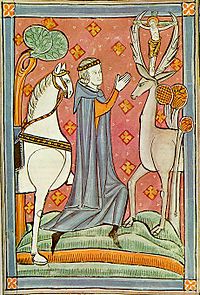
Conversion of St Hubert (Image from Wikipedia)
Shortly after I had my idea for a panel depicting the Vision of Placidus, I went to London for a lecture. The Pisanello is in The National Gallery, so after the lecture I took the opportunity, before catching the train home, to go to see the painting in real life. It turns out that St Hubert had a similar Conversion experience, so as well as the Pisanello “Vision of St Eustace” I found a fragment of an altarpiece entitled “The Conversion of St Hubert”…
I eventually tracked down the Pisanello, in the Sainsbury wing, and found it very much smaller than I expected – about A2 in size – which is much smaller than I am planning (about five foot by three foot). It was also just as dark as the reproduction I showed you in the first post about this idea. I sat down on a convenient window seat nearby, and started taking notes of the further research I need to do.
I will need picture references for
- a horse reined in from a gallop
- a stag with huge antlers
- hounds alert but not moving
- forest flora and fauna
- crucifix
- rocky outcrop
- suitably rich and exotic clothing for the huntsman
I also want to differentiate the vegetation from the background rather more, pull the rocky outcrop away from the background a bit more, and make the crucifix seem to grow out of the antlers rather more than it does in Pisanello’s painting.
While I was there, I sketched a very approximate idea of the space I want in the picture – the Pisanallo and the altarpiece, and the picture above, are all quite compressed and condensed, and at the moment my idea is to have much more space and “air” in the design.
When I got home I had another go, this time in pastels. Some elements of the pastel work quite well – the horse and its harness, and the crucifix between the deer’s antlers. Others are not so good – the trees in the background are too regularly spaced and too similar in shape, and, like the Pisanello, there isn’t as much space between the stag and the horse as I would like.
I need to be careful, here. If I concentrate too much on creating painted sketches, I might drive out all the stitching ideas, but at the same time, the more I think about the design, the better the chance I have of producing a panel I am happy with!
Vision of Placidus – a project for the distant future…

Pisanello “Vision of St Eustace” (Image from Wikipedia)
Lately I have been re-reading a favourite book, “The Herb of Grace” by Elizabeth Goudge. In it, her fictional family discover in their house – a medieval Pilgrim Inn – an ancient fresco, depicting the conversion of Placidus. It is described as being very like Pisanello’s “Vision of St Eustace”, now in the National Gallery – Placidus changed his name when he converted to Christianity – but with the local wood and its animals forming the background. In fact, so enchanted was the fictional artist by the local wildlife that he filled every gap in the trees with animals, even putting land animals in the sky to fit them all in.

La Dame à la licorne. (Image from Wikipedia)
It is this element that appealed to me, as it is reminiscent in some ways of my favourite textile, in my favourite museum in all the world – La Dame à la licorne, in the Musée de Cluny in Paris. This is a set of medieval tapestries, depicting the mythological hunt for the unicorn, and the set is displayed in a circular room, with a set of steps down into it. When I first saw it, I sat down very suddenly on the steps, and didn’t move or speak for a good ten minutes, which gravely disconcerted my companion at the time. I’ve since dragged various friends and relations there, too, just to give myself another opportunity to visit the tapestries, not to mention visiting the Gobelins Manufactory in order to find out how such tapestries were made!
One day, I would like to create my own panel, linking La Dame à la licorne with the Vision of St Eustace. There are so many textures – the fur and feathers of the animals and birds, the splendid trappings of Placidus’ horse and his own clothes, the forest trees and flowers, and the rocky outcrop where the stag turned to face him. Just think of the wonderful variety of stitches and threads I could use!

